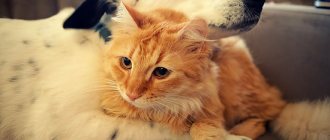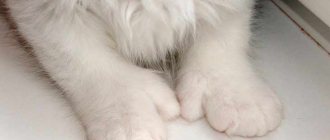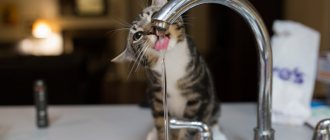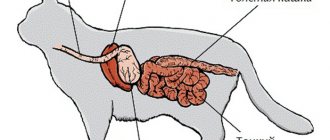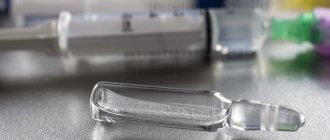Swallowing disorder is called dysphagia. This condition occurs in cats of all ages. In some cases, a cat cannot swallow a piece of food because it hurts. The pet's head twitches to force food to slide into the esophagus.
In other situations, swallowing becomes difficult due to paralysis or blockage of the throat. What are the causes of dysphagia? In what cases is there a threat to life? When is urgent veterinary care required? This article answers the questions raised.
Types of dysphagia
Fights cause dysphagia.
Swallowing disorders are divided into anatomical and functional. Morphological dysphagia can be congenital or acquired due to injury. Functional ones develop as a result of inflammatory or neurological diseases.
Based on localization, the following types of disorders are distinguished:
- Oral: The animal is unable to grasp food or form a bolus using the tongue and mouth. The cat chews for a long time, shaking its head so that the food falls into the throat.
- Pharyngeal: the relationship with the swallowing and gag reflexes is disrupted. Some of the food is regurgitated and ends up in the nasal passages. If the larynx becomes blocked, the pet dies from suffocation.
- Esophageal or esophageal. Food gets stuck in the esophagus and does not enter the stomach. A cough occurs, causing vomiting. The animal is starving and quickly loses weight.
Norms for kittens by month of life
The decision on how many times a day to feed a kitten depends on the baby's age in months. During growth and development, the cat's body requires more feedings throughout the day.
From birth and during the first month
If a newborn kitten is separated from its mother for any reason, then the responsibility of feeding the kitten falls on the shoulders of the person. If you couldn’t find another cat that could feed you with its own milk, you should feed the kitten without a mother a special formula. You can use infant formula for newborns.
It is forbidden to give a newborn kitten whole cow's milk in the first month of life; this is a very heavy food.
To develop the sucking reflex, it is advisable to use a bottle when feeding. You can try feeding from a pipette.
During the first three days you need to feed every two hours, including at night. Then, by the 10th day of life, the interval between feedings is increased to 4 hours. For the first two weeks, the daily intake of formula for a kitten is 30-40 ml per 100 g of baby’s weight.
A one-month-old kitten should be fed exclusively with formula, increasing its volume to 50-55 ml per 100 g of weight by day 30. Then start feeding him adult food.
1-2 months
The age of a kitten from a month to two months is the time to accustom it to food in pieces. By the end of the second month, the kitten should eat about 200 g of food, which is divided into 5 feedings. You can offer him oatmeal or rice milk porridge with the addition of a chicken egg. If ready-made food does not cause digestive upset, then you can completely switch the kitten to natural feeding.
2-3 months
A 2 month old kitten needs to be fed 4 times a day. He can already eat about 300 g of food, cut into small pieces. For example, you can offer minced meat.
3-4 months
A 3 month old kitten needs to be fed 3 times a day. The total volume of food eaten is approximately 360 g. Until this age, pieces of dry food must be soaked in water when feeding. At 3 months, kittens change their teeth and can already be introduced to solid food.
4 months and older
By this time, the kitten’s menu should consist of 75% meat protein foods.
Under no circumstances should you feed your kitten raw or fresh meat. This threatens protein intoxication or infection with parasites.
By six months, you can gradually transfer the grown kitten to two meals a day.
Causes of swallowing disorders
Gingivitis
The swallowing process is disrupted under the influence of the following pathogenic factors:
- Mechanical: occur when a foreign object is inserted into the soft tissues of the mouth or the food tube is blocked. An embedded fish bone causes pain and interferes with the act of swallowing. A curious pet plays with small parts of toys or devices scattered on the floor, swallows them and blocks the lumen of the pharynx or esophagus.
- Traumatic: damaged soft tissues become inflamed and swollen, pain or narrowing of the food passage due to a formed scar prevents swallowing.
- Congenital: anatomical abnormalities prevent the normal passage of the food coma. Most often they occur during spontaneous selection, when mating partners are not selected taking into account pedigrees.
- Errors in feeding , in which food particles are retained on the gums. Plaque occurs, tartar forms, and gingivitis develops. The act of swallowing becomes painful.
- Inflammation of the lymph nodes due to hypothermia from frozen food, burns that are too hot, and infectious diseases.
- Formation of ulcerative defects of the mouth as a result of calicivirus infection.
- Paralysis of the masticatory muscles due to tick-borne or viral infection, poisoning, autoimmune processes.
- Swelling of the pharynx under the influence of irritating factors
- Traumatic brain injuries.
- Tumors.
Be sure to read:
A kitten's eyes are festering: normal or pathological, reasons, what to do at home, medications
Cat diet in numbers
Feeding standards for cats depend on many factors:
- age;
- gender;
- size and weight;
- breeds;
- health conditions;
- lifestyle;
- type of food - dry, canned, natural products;
The question may arise: does the number of feedings depend on calorie content? Depends directly. This is one of the most important factors that determine the size of portions and their quantity throughout the day.
A cat will need more food if its food is low in nutritional value. It is better to choose a diet that, without compromising health, will satisfy the needs of twice feeding, morning and evening. It is better to choose a higher nutritional value over the amount of feed.
The optimal calorie content of the daily diet should be about 70 kcal per 1 kg of weight. Depending on the calorie content, the weight in grams of the daily norm is determined at the rate of 30-60 g per kg of the cat’s weight and is about 250 g.
Thus, an adult, healthy cat weighing 5 kg can eat 250 g of food per day with a total calorie content of 350 kcal.
Cats have a high need for amino acids. The meat and protein component in their diet is preferable to vegetables or cereals. Carbohydrates in the daily amount of feed should be no more than 3%, fats - no more than 15%.
Clinical symptoms and diagnosis
With calcivirosis, problems occur with swallowing due to ulcers on the tongue.
Dysphagia can be suspected based on the following pathological symptoms:
- profuse salivation with or without blood;
- cough and regurgitation after feeding;
- gagging;
- chewing food on one side of the jaw if dental disease has occurred on the other;
- halitosis - stench from the mouth;
- crusts around the nose;
- picky eating;
- exhaustion;
- curvature of the neck;
- head shaking;
- plaintive meowing for no apparent reason.
The initial diagnosis is made by the cat owner if he notices at least 2 or 3 of the listed pathological signs. The cause of the disease is determined based on a clinical examination of the medical history and additional studies prescribed by a veterinarian.
When to sound the alarm
Warning signs:
- puffiness, swelling of the eyelids;
- redness of the mucous membranes, inflammation of the conjunctiva;
- changes in behavior (drowsiness, depression);
- inadequate reaction to light, photophobia;
- the appearance of a whitish film on the eyes;
- unstable temperature;
- digestive problems;
- corneal clouding;
- formation of crusts on the eyelids;
- frequent blinking, squinting.
Discharge from the eyes can signal not only ophthalmological problems (corneal injuries, entropion of the eyelids, uveitis, keratitis, obstruction of the tear ducts), but also indicate the development of a parasitic, viral, fungal, bacterial infection (rhinitis, otitis, herpes virus infection, chlamydia). Therefore, if you notice any signs of discomfort, do not delay your visit to the veterinarian.
Treatment and prevention
Feeding through a nasoesophageal tube
Treatment consists of eliminating the cause of the disease and diet therapy.
For conservative treatment, medications of the following groups may be needed:
- antibiotics;
- immunomodulators;
- anti-inflammatory corticosteroid drugs;
- external wound healing agents.
Since swallowing is difficult, food is served in liquid form; if it is refused, it is forcibly administered through a nasoesophageal tube.
Restorative procedures involve parenteral administration of a mixture of electrolytes and detoxifiers, and, if necessary, water-soluble vitamins.
Surgical treatment is used to remove a foreign body, remove a diseased tooth or tumor. Congenital anomalies, as well as certain traumatic injuries, cannot be treated.
Teeth cleaning
Prevention consists of the following actions:
- Complete nutrition with prepared food of at least premium class. If plaque forms, use special food to remove food debris from the teeth and gums.
- Use natural cat toothpaste and brush.
- Do not treat your pet to fish with bones that could get stuck in the mouth or throat.
- Do not scatter small parts of toys or devices on the floor that your pet could swallow.
- Do not offer frozen or too hot treats.
- Vaccinate your pet in a timely manner in accordance with the vaccination plan.
- Use insectoacaricidal agents to protect the animal from arthropods.
- Carefully select pairs for mating. Eliminate the possibility of inbreeding.
Be sure to read:
A cat sneezes: causes, symptoms, what to do, treatment methods, what should alert you
Tearing in cats during or after eating
This phenomenon may have several reasons, among which we note:
- breed, genetic predisposition;
- allergies;
- congenital defects of the skull structure;
- blockage of tear ducts;
- unbalanced, low-quality diet;
- eversion, entropion, cataract;
- distichiasis (improper eyelash growth);
- foreign bodies in the eye;
- endocrine diseases, disruptions (diabetes mellitus);
- eye injuries;
- helminthic infestation;
- dacryocystitis (non-infectious inflammation of the lacrimal sac);
- digestive problems;
- close location of the upper teeth to the nerves of the eyes;
- individual, physiological characteristics of the body.
If the cat does not have chronic, acute pathologies, the production of tears while eating is a clear sign of a food allergy. (liver, beef, legumes, rice, soy, milk) can act as allergens Especially often, nutritional allergies develop against the background of an unbalanced diet, if the cat is fed low-quality “economy” food.
Feeding cats
Content
- What and how to feed a cat correctly?
- Natural feeding
- Feeding with prepared industrial feeds
Owners often ask veterinarians what is better to feed their cat - ready-made (industrial) food or natural products. Let's look at the details of the feeding behavior of cats and the associated features of each type of food.
What and how to feed a cat correctly?
First of all, it should be noted that the domestic cat (lat. Felis catus) is an obligate, that is, an obligate predator, adapted to feeding mainly on meat. Anatomically, this is expressed by the structure of the teeth, adapted to capturing and tearing the victim, as well as by the simple structure of the digestive system with a short intestinal length, complete transit of the contents through which occurs in a relatively short 18-24 hours. In addition, cats lack some digestive enzymes found in omnivores. Protein is their main source of energy. The natural diet of cats in nature is rich in animal proteins and fats, but poor in carbohydrates. The only carbohydrates in the diet of wild felines are the semi-digested intestinal contents of their victims. The cat’s body is not able to independently synthesize the vital amino acids arginine and taurine, vitamins B3, A and D, linoleic and arachidonic acids (omega-6 fatty acids), so the listed ingredients must be present in their diet.
Cats exhibit strong hunting behavior, and also, by nature, love variety and strive for everything new. Unlike most mammals, they do not exhibit uniform daily rhythms of sleep, activity, food and water intake, however, they are nocturnal. They are most active at dawn and dusk, when their prey is most active. In nature, a cat's food intake and body weight are regulated, but in a domestic environment, a cat expends very little energy on obtaining food and is therefore prone to weight gain.
People have a huge influence on the feeding behavior of these animals, because their owners single-handedly decide their fate, including determining the cat’s feeding regimen. Therefore, it is so important to understand the intricacies of caring and feeding your pet in order to help her be healthy and cheerful for many happy years of life with you.
What food is best for your pet, taking into account its biological characteristics?
Natural feeding
Suppose you are prejudiced against dry kibbles of ready-made food and you want to give preference to natural feeding of cats. This is good, because you can independently control the quality of the food your pet receives. But it is important to understand: you need to cook separately, scraps from your table are not suitable! The freshest and most beautiful porridge, borscht and cutlet of excellent (in your opinion) taste will lead the cat to illness and suffering, and you will spend money on a veterinarian. How to avoid this?
So, this animal needs protein, the main source of which remains meat. It is correct to feed cats beef, chicken, turkey, and rabbit. Pork and lamb are best avoided. We must keep in mind that our animals, like you and me, are susceptible to allergies, including food allergies. Chicken, being a source of complete protein, is often the cause of food allergies - most likely due to the numerous additives that chickens receive when raised in modern poultry plants. But the nutrition of animals with health problems is a separate topic that remains beyond the scope of this article.
The chosen meat should be lean; it is possible (and good!) - with films. If you plan to feed it raw, you need to freeze and defrost before feeding. You can pour boiling water over it. You can boil it a little. Grind into small pieces (chop), but do not make mince! Minced meat passes through the digestive tract very quickly and does not have time to be absorbed.
Fish is also a source of complete protein for cats, but with fish it’s a little more complicated. Marine, freshwater... Some types can be given raw, others absolutely cannot... Bones are large or small... Different fat content... You will need to make a long list and keep it on hand at all times so as not to harm your pet. For example, hake or halibut can sometimes be given to an adult healthy animal.
So, protein should make up the majority of the food portion, approximately 4/5 of the cat feeding norm. The remainder is carbohydrates, fiber, vegetable and animal fats. Their sources will be cereals (any grain that your animal likes), vegetables (let it be carrots, broccoli, cauliflower, beets), a little greens (lettuce, sprouted grass, dill, parsley). Cereals and vegetables need to be boiled. Plant and animal fats normalize digestion and metabolism, in particular, they serve as a source of fat-soluble vitamins and essential fatty acids. The latter affect the protective barriers of the skin and coat and the quality (beauty!) of the coat.
How to achieve the correct ratio of ingredients and feed your cat according to the rules? You can, for example, measure with a tablespoon. For 4 tablespoons of meat you will need 1 spoon of everything else, more than half of the fifth spoon will be taken by vegetables, and the lesser half will be porridge. Pour vegetable oil on top with a teaspoon, add animal fat in the form of butter or sour cream to the porridge and vegetables. The total amount of food depends on the age and weight of the animal; the main guidelines for proper nutrition are activity, vigor, and shiny coat.
Of course, this calculation is very approximate. You can use a home kitchen scale and weigh everything, focusing on the fact that the weight of a healthy adult cat's daily diet should be 5% of his (or her) body weight. 80% of the serving should be meat, 15% vegetables and 5% grains.
For example, let the average domestic cat of the mixed breed, also known as outbred, weigh about 4 kg. Such a cat will need approximately 200 g of food per day, of which 160 g will be meat, 30 g of vegetables and 10 g of porridge, as well as a teaspoon of fat and a few drops (or tablet, capsule - depends on the manufacturer) of vitamin and mineral supplements.
You should not give fruit, as this will most likely lead to flatulence and other intestinal disorders. Milk is an excellent food, but not for adult cats; it also causes digestive upsets in most of them. To diversify the diet, you can offer your cat fermented milk products in the form of low-fat kefir and yogurt without additives 2-3 times a week. Sometimes replace meat with fish. Offer another type of cereal, another vegetable. Such a variety of tastes will be enough to make your pet feel happy, taking into account the characteristics of its nature.
When feeding domestic cats with natural food, it is imperative to add ready-made vitamin and mineral complexes to the food. A veterinary clinic or specialty store will help you choose the right one, taking into account the characteristics of your animal.
Remember that feeding raw or semi-raw meats and fish increases the risk of helminthic infestation; do not forget to carry out regular (once every 2-3 months) deworming - give anti-worm tablets.
It is important not to forget that all of the above applies to healthy adult animals of young and middle age. Feeding kittens and older cats requires special attention. Older cats require less energy, and in addition, many older cats exhibit certain ailments. Pets over ten years of age should be regularly seen by a veterinarian, even if at first glance they do not have any problems. A preventive examination and consultation on nutritional habits at this age will help prevent illness.
As for kittens, in general, their diet should be 10% of their body weight. Given the rapid growth, the amount of feed should be checked regularly. For successful development, kittens require complete protein, but when fed only meat (and such cases, unfortunately, are not uncommon!), kittens develop a disease - secondary (nutritional) hyperparathyroidism. With this disease, the ratio of calcium and phosphorus changes, calcium is washed out, bones become brittle, which leads to pathological fractures.
Feeding with prepared industrial feeds
Many owners who take a responsible attitude to the issue of providing adequate nutrition for their pets find it quite difficult to calculate the correct ratio of ingredients and prefer to feed their cats with ready-made industrial food. Of course, this is very convenient. In addition, it should be taken into account that well-equipped laboratories of companies producing ready-made animal food cope with calculation tasks much better. These days, in any specialty store you can find long rows filled with different brands of cat food and there is a great opportunity to choose the best option for your animal’s health, appetite, and your budget.
All feeds are conventionally divided into two groups. To one we include those that are cheaper, to the second - food of the so-called premium and super-premium classes. Both groups of food offer BALANCED diets, and the difference in price is due to the sources of ingredients, and, above all, proteins. Even if you cannot afford to feed your animal more expensive and high-quality premium and super-premium food, any balanced diet will in any case be better than if you offer your pet leftovers from your table.
Ready-made food can be dry or wet, respectively. The ideal option is to offer your pet 1/3 wet food and 2/3 dry food of the same type, from the same manufacturer. You need to choose taking into account the age group and other characteristics. Many manufacturers now offer food specialized both for the breed characteristics of the animal (sometimes specifically designed for a particular breed), and for the character and lifestyle: for example, food for adult cats living at home or going outside, or for cats with long hair. wool (contains additional ingredients that help remove hair swallowed during self-grooming), etc.
Your task is to find a suitable store with a wide assortment, choose the right food and offer it to your pet. It is important to keep in mind here that if your animal has been eating something different until now, and from now on you decide to switch to a proper, balanced diet and buy good food, then the transition to it should take place at least 5-7 days in advance. and better for 14.
Another important truth is that you can’t mix the food: if you feed it with a commercial ration, then that means only it. You cannot add dry food to natural food. You can’t give meat in the morning and put out a bowl of dry food in the evening. The key word to understand the essence is “balanced”! Industrial feeds are like that, and when you mix something with something else, the balance is upset. It is for this reason that there is also no need to add any vitamin and mineral supplements to ready-made industrial feeds for healthy animals!
But this does not apply to the transition period! Here your task is to gradually accustom the cat and its taste buds to a new taste, to allow its body, its enzyme system, to gradually adapt to a new type of food. This is why you need to change your diet gradually. For example, on the first day, put two bowls - the usual portion and a little new food on the second. The cat will eat its usual lunch and get acquainted with the smell and appearance of the new one. The next day, you can slightly reduce the portion of your usual food. Perhaps, without finishing, the cat will try a new dish. Then combine the old and the new in one bowl, and there will still be much more of the old. Well, gradually, only new food will appear in the bowl, but by this moment your pet will already be well prepared. Of course, each cat has its own character; basically, they are inquisitive and open to everything new, but not all of them. Therefore, someone’s cat will be happy to try new food, while someone’s cat, even if it doesn’t finish eating a little, will not want to switch to a new bowl for a long time. Therefore, it is necessary to switch to a new food taking into account the character and individuality, but, in any case, carefully and not immediately.
For pet owners just switching to commercial food, it will be a revelation that the portion size pets receive will now be reduced. As a rule, manufacturers print recommendations for use on food bags, including the amount of food per animal weight and the frequency of feedings. Industrial feeds are more concentrated, so their quantity will be smaller.
However, many owners neglect to calculate quantities and organize constantly accessible “buffet tables” for their pets, leaving bowls of food available around the clock, adding them from a jar “by eye” as they are eaten. Both dry and wet food that we offer to our animals must be strictly dosed in accordance with the manufacturer's recommendations. But not only that, it is necessary to regularly weigh the animal and evaluate it by appearance and size of the fat fold. It is better to entrust the latter to a veterinary specialist, because owners who see their beloved pet day after day lose objectivity. There are often cases when a very overfed cat is brought to an appointment and they are very surprised when they hear that their animal is obese; sometimes they even try to convince the doctor that the cat has just lost a lot of weight and needs strengthening.
Another important point when feeding prepared foods is maintaining the water regime. The distant ancestors of our domestic cats were steppe cats from arid regions, and in those days the only source of moisture could be the meat of the victim. Therefore, genetically, cats are generally not very prone to drinking water. Naturally fed cats may not drink at all or drink very little. They can do this secretly from the owner, using not only their bowl, but also what they find. But cats switched to commercial dry food critically need to get enough water. This should be fresh water, which you will change at least once a day, and more often in hot weather. It is better to use bottled drinking water or filtered water. The drinking bowl should be made of stainless steel or ceramic, because plastic can spoil the taste of water.
Some cats, despite all their efforts, still neglect to drink, and then special measures have to be taken to convince them.
In many families, cats traditionally live with people from generation to generation, and people consider themselves specialists in keeping and feeding. And someone gets their first kitten and has absolutely no idea where to start or how to properly care for it. It is interesting that both make mistakes, but the second of the mentioned categories of people more often comes to veterinary specialists with questions.
In conclusion, I would like to urge owners of domestic cats to take care of their pets, maintain their health, check themselves, and even consult with professionals on such a seemingly simple issue as feeding.
The article was prepared by doctors of the therapeutic department "MEDVET" © 2014 SEC "MEDVET"
Periodontal disease
Symptoms:
- Bad breath. One of the main reasons for visiting a veterinarian. The smell from the mouth becomes unbearable, putrid in nature, and can be felt from afar (when the animal enters the room).
- Decreased appetite. The cat wants to eat, but cannot. Refuses the once-favorite “crackers”, preferring soft food.
- Strange behavior. Owners notice how the pet shakes its head, rubs its muzzle with its paw, as if trying to get something out of its mouth. Sometimes you can clearly hear teeth grinding. The cat slurps when chewing. After eating, the lower jaw may tremble.
- Constant discharge from the mouth. A sick animal will drool profusely. Blood or pus may occasionally leak from the mouth. The fur on the chin is wet all the time, the skin becomes inflamed.
- Tartar and gum inflammation. If the cat is calm, you can move the upper lip and look into the mouth without opening its mouth. It is easy to notice yellow-brown tartar - massive hard deposits that sometimes completely cover the tooth itself. The gums are bright red or bluish in color and bleed. When pressed, a pus-like gray mass may come out from under it.
Treatment:
1. Hygienic cleaning of teeth from plaque and tartar at the initial stage of the disease. After this procedure, the crowns are coated with a fluoride-containing protective varnish. I treat the gums with antiseptic solutions and dental ointments (for example, Metrogil Denta).
2. Surgical intervention.
============================================================================================================================================================================================
Veterinarian advice
You can calm a cat that regularly yells at night with the help of medications or folk remedies, but veterinarians advise not to abuse either one. It may well be that the reason for your pet’s yelling lies in adaptation to the new home, fear of strangers (if you have guests), aggression towards other four-legged residents. The best remedy against yelling in this case is affection and attention.
If you nevertheless decide to resort to a sedative, veterinarians advise:
- do not abuse such drugs, as they are quickly addictive, and in the worst case, lead to serious health problems;
- closely monitor your pet’s well-being - the slightest signs of illness in the form of excessive drowsiness, nausea or vomiting may indicate an atypical reaction of the body to any component;
- Don’t buy a drug just because it helps your neighbor’s dog—the same dose will have different effects on animals of different species, sizes, and genders.
Before purchasing any sedative for your cat, be sure to consult with your veterinarian.
Why can a cat yell?
Your pet's loud cries can be heard at any time: in the middle of the night or in the morning. Some vocalize during the day. And there are also those who are able to scream around the clock. For animals of the Oriental breed this is the norm, but for other pussies there is always a good reason for such behavior.
Hormones
During the period of heat, all non-sterilized cats scream without exception. The desire to have offspring is so strong that it causes the animal not only psychological, but also physical torment. The same fate awaits a cat if it is not neutered.
In addition, during mating, a loud cry is a signal for an individual of the opposite sex. The cat reports that he is full of strength, energy and longs for love. Of course, a constantly screaming animal causes discomfort to the owners, especially if concerts take place in the morning or at night. But this is a natural phenomenon that cannot be fought. All you have to do is wait patiently for the difficult period to end.
Disease
If an old cat constantly yells, he may have Alzheimer's disease or a nervous disorder. This is a consequence of irreversible age-related changes in the animal’s body. The owner should consult a veterinarian. There are a number of medications that can alleviate your pet’s condition and help him calm down, at least for a while.
The heart-rending cry of a young cat may indicate some kind of injury or severe pain. Perhaps the animal is experiencing acute pain in the abdomen. The owner will be able to determine this by carefully palpating the cat. Normally, the abdomen should be soft, and gentle pressure should not cause concern. If the abdomen is hard, swollen, resembles a drum, and the animal furiously scratches the owner’s hands, then you need to immediately go to the veterinarian.
Helminth infections can also cause previously calm purrs to scream at night. Worms cause pain in the intestines and often even lead to intestinal obstruction. Preventive treatment of your pet against worms should be carried out regularly, starting from the third week of life.
With urolithiasis, furry cats also feel acute pain. They meow pitifully and loudly every time they try to go to the toilet. If such signs are noticed, you should immediately contact a veterinarian.
To attract attention
Sometimes a pet walks and yells for no serious reason, just attracting attention. Adult cats quickly understand that a person is reacting to a loud cry, and thus try to achieve what they want. Sometimes this is persistent begging for a treat. Some vocalize when they are hungry. If it’s not clear why your pet started yelling, you should try giving him a treat. Perhaps he will calm down after this. But if this phenomenon occurs again, ignore your pet's requests. Otherwise, the cunning creature will get used to it and will constantly terrorize its owner.
It also happens. Your pet spends most of the day alone at home, and simply lacks attention. He tries to attract the owner's attention by shouting in order to get his share of affection. Calming a kitty is simple - you need to play and talk to it so that it does not feel forgotten. When leaving your cat alone at home for a long time, provide him with toys and food so that he can keep himself occupied with something.
Anxiety
The cat expresses its anxiety with heart-rending screams and incessant meowing. This could be a premonition of some event, even a natural disaster. Fluffies also react strongly to changes in weather. Among them, as among people, there are weather-sensitive individuals.
Fight for territory
From their wild ancestors, modern cats have received many instincts that do not disappear, despite the changed conditions of existence. One of these instincts is the fight for territory.
To claim its rights, it is not enough for an animal to put marks. It is necessary to declare oneself with a loud cry so that rivals do not even risk entering into a fight with him. This behavior is often observed after moving to a new place of residence. This is not a pathology, but a completely natural phenomenon that will pass over time.
Yearning
A small kitten that has just appeared in the house can also scream loudly in the first days. The reason is longing for the cat mother, who was nearby just recently. The baby meows very loudly and pitifully. To calm him down, try to distract him with an interesting toy or just be nearby.
Reaction to inappropriate behavior of the owner
Not all cat owners are madly in love with their pets. Of course, a small and fluffy kitten evokes affection in most people. But over time, the baby grows up, becomes an adult wayward animal and begins to irritate its owners. Constant slaps, kicks and loud screams force the cat to defend itself. He actively marks his territory and screams loudly, instinctively trying to scare you and drive you out. The problem has a solution - you just need to change your attitude towards your pet.



